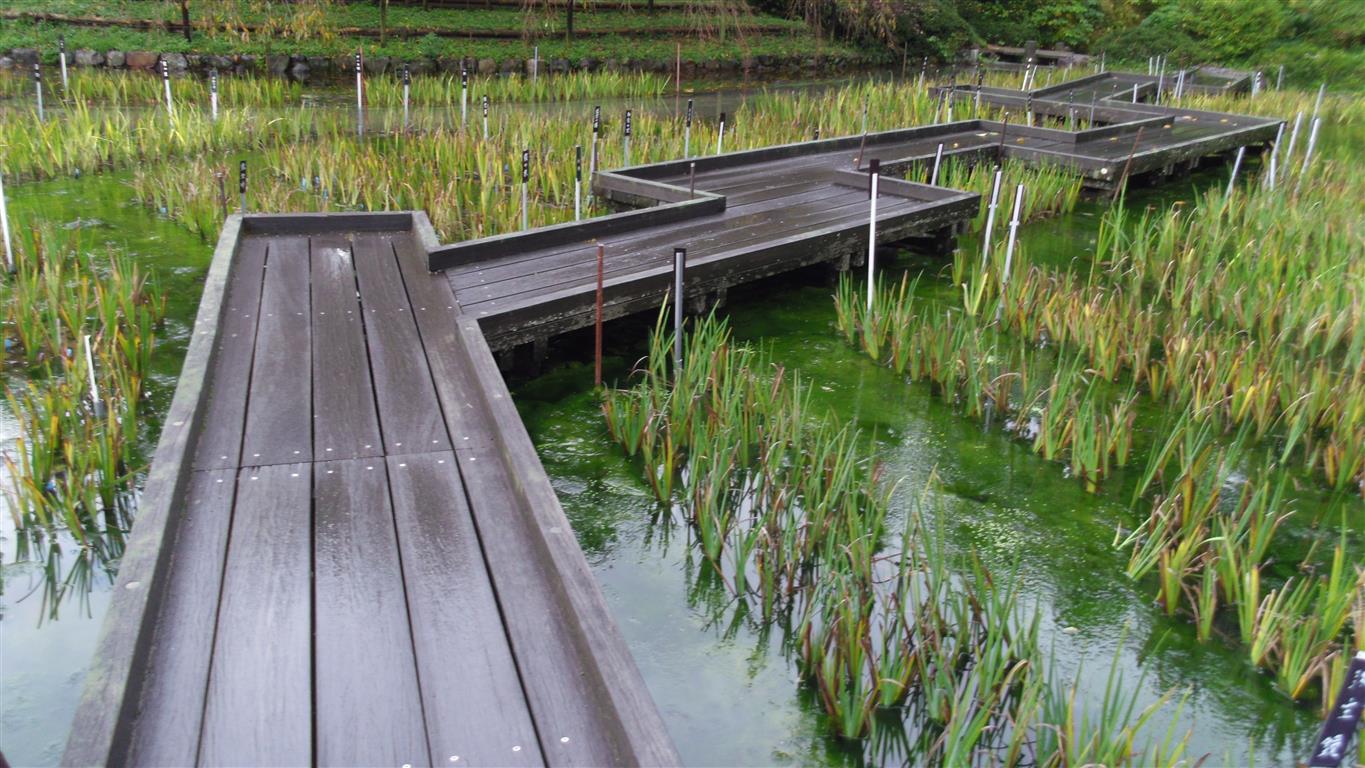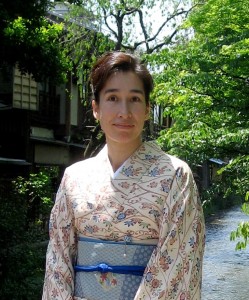
In this post we have a special excerpt from Deep Kyoto: Walks written by Izumi Texidor Hirai. In her walk through the Botanical Gardens, Izumi weaves personal recollection with finely observed details of life in the gardens as they pass through the four seasons. Let today’s excerpt from Izumi’s walk serve as a happy reminder of all the special seasonal joys that the year ahead has in store.
***************************************************
The Botanical Gardens
IZUMI TEXIDOR HIRAI
The Rose Garden is my favourite part, like stepping into an English garden. A couple of tables shaded under tall trees, roses blooming in every colour I can imagine, grass and gravel under my feet, and then Mount Hiei quietly standing there at the end. Before I notice it, my steps have become smaller and slower. My eyes want to look at all those roses, every single one of them, and my lungs want to breathe in as much of their aroma as they can. In full bloom, this garden is spectacular and many people gather here to take quick photos or to slowly sketch their favourite bloom. However, I quite like it around November, on a cool, rainy day. I like the smell of wet earth and the rain drops on the flowers and on the leaves, and I like to see Mount Hiei mysteriously surrounded by grey clouds. I like that there is no one around and all I can hear is the continuous whispering of rain. I wonder if it sounds the same down here amongst the roses, as up there, at the top of Mount Hiei. In the spring, I will sometimes sit at one of the tables under the big pine trees and read or study. It is one of those special places where time stops as people come and go.
Now I have had my fill of roses, I want to explore the rest of the place, so I stand up, leave the Rose Garden behind and head north. Depending on the time of year, I will see camellias, or irises coming out of a lotus pond, or big hydrangeas if it is June. The lotus pond has an interesting bridge that often reminds me of classic Japanese novels. It is not a straight bridge or even a typical slightly elevated bridge, it goes right and left, and then right and left again, making you understand that the point is not to go from here to the other side, but to walk slowly and look around, maybe even stop a couple of times and enjoy a certain spot. When I get off the bridge, I start walking freely, no longer really having any direction in mind. All that zig-zagging. Wherever I go, I am always shaded by big old trees that must have seen a hundred years go by. There are more than twelve thousand species of plants and trees in these gardens, and birds live in some of these trees. I have often seen bird watchers with the latest cameras, moving silently in groups and taking fast snaps. Like modern ninjas.

Then the sound of bamboo makes me slow down again. It is not a big forest, like the famous bamboo forests that people visit in other parts of Kyoto, yet still bamboo has this way of standing there, strong yet soft, that always transmits depth. At least it always makes me have deep thoughts. I think of how graceful the bamboo shoots look, but how strongly rooted they are to the earth, and how fast they separate from it, to grow higher and higher, while their roots go deeper and deeper, in a constant yet invisible effort to live. And then there is that sound. The wind finding its way through the shoots and the leaves. And the shoots and the leaves moving together with the wind, being flexible, but never bending, always going back to their straightness. It makes me think of how I want to be.
Still half lost inside my green thoughts, I continue my stroll. If I go north, I will see a big fountain that makes kids happy during the summer months, and just next to it, an area with all sorts of seasonal flowers. I like walking in there, not only because of the colours and all the flowers I never knew existed, but also to feel the effort that someone put into that seasonal garden. This is something that I have always admired in Kyoto, the effort people put into their tiny entrances, filling them with small pots neatly cared for. These minuscule urban gardens make such a big difference. A small effort will surely always make a difference.
***************************************************
Text and photographs by Izumi Texidor Hirai. To read the rest of this story, you can order the anthology Deep Kyoto: Walks as a paperback or e-book from Amazon.com, Amazon.co.jp, or Amazon.co.uk.
 About Deep Kyoto: Walks
About Deep Kyoto: Walks
Deep Kyoto: Walks is an independently produced anthology of meditative strolls, rambles, hikes and ambles around Japan’s ancient capital. All of the writers and artists involved in this project have lived and worked in Kyoto for many years and know it intimately. The book is in part a literary tribute to the city that they love and in part a tribute to the art of walking for its own sake.
About Izumi Texidor Hirai
 Izumi Texidor-Hirai is half Japanese and half British, but born and raised in Barcelona. She first came to Japan in 1998 to study at Tokyo University. After many travels she returned to Japan to work for FIFA during the 2002 Japan/Korea World Cup. She decided to stay on after the event and moved to Kyoto, where her family have roots. Izumi had always admired kimono and took this chance to go to a kimono school, where she trained to become a kimono teacher. This course led her to the world of cha-no-yu (tea ceremony) which has since become her passion. Izumi is currently working towards a degree in Traditional Chinese Medicine, studying QiGong with a sensei in the Imperial Palace grounds, wearing kimono most days and continues to be very passionate about cha-no-yu.
Izumi Texidor-Hirai is half Japanese and half British, but born and raised in Barcelona. She first came to Japan in 1998 to study at Tokyo University. After many travels she returned to Japan to work for FIFA during the 2002 Japan/Korea World Cup. She decided to stay on after the event and moved to Kyoto, where her family have roots. Izumi had always admired kimono and took this chance to go to a kimono school, where she trained to become a kimono teacher. This course led her to the world of cha-no-yu (tea ceremony) which has since become her passion. Izumi is currently working towards a degree in Traditional Chinese Medicine, studying QiGong with a sensei in the Imperial Palace grounds, wearing kimono most days and continues to be very passionate about cha-no-yu.
************************************************************************************